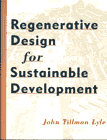Book Review
Regenerative Design for Sustainable Development
by John Tillman Lyle
Paperback
- 352 pages
(November 1996)
John Wiley & Sons;
Dimensions (in inches): 0.89 x 10.97 x 8.54
I first became aware of the late John Tillman Lyle when he spoke at a 1995 conference on sustainable building in Santa Barbara, California. I chose to attend his presentation over several others in the same time slot because I was attracted to his subject , "The Design of Human Ecosystems." His talk impressed me even more than his title promised.
In that presentation and his book, Regenerative Design for Sustainable Development, professor Lyle looks at the BIG PICTURE of ecological design, placing it in its historical context and discussing the core issues. Yet he includes enough detailed design information so his book can serve as a step by step design manual. Most importantly, from my view, is his underlying assumption that the purpose of ecological design is to regenerate an already badly damaged planet.
The book's first section, "Rethinking the Mind in Nature," opens with a general discussion of sustainability and the impending demise of what he calls the paleotechnic (industrial) and ascendancy of the neotechnic (ecologically modeled) eras of development. He then discusses design and the regenerative design process (as opposed to today's business-as-usual design process). He concludes the opening section with explanations of his eleven strategies for regenerative design:
- Letting Nature Do the Work
- Considering Nature as Both Model and Context
- Aggregating, Not Isolating
- Seeking Optimum Levels for Multiple Functions, Not the Maximum or Minimum Level for Any One
- Matching Technology to Needs
- Using Information to Replace Power
- Providing Multiple Pathways
- Seeking Common Solutions to Disparate Problems
- Managing Storage as a Key to Sustainability
- Shaping Form to Guide Flow
- Shaping Form to Manifest Process
Understanding Lyle's eleven basic design strategies would, in and of itself, more than justify buying and reading his book. But his strategies are only the beginning. The next seven chapters explain how to provided our basic life requirements—energy, food, water, shelter, the distribution of goods—through ecologically sound means, showing how his design strategies are applied to meet our needs without compromising those of the planet. Where it is appropriate, he co-authors chapters with experts on the topic discussed. And throughout, he keeps to his theme of regenerative design based on ecological models.
Lyle presents many case studies, including that of design and development of the Center for Regenerative Studies at the California State Polytechnic Institute at Pomona, which he directed. As a professor of landscape architecture at the Institute, he was in a position to bring a wide-ranging team of experts, including energy analysts, agriculturalists, and even an anthropologist to participate in the design process. The Center's design is exciting, and bears careful study.
Finally, Regenerative Design is nicely appointed with simple schematic diagrams and sketches illustrating the flow of energy and goods in human and natural ecosystems. I can make no higher recommendation than that I use Lyle's superb work as the textbook for my Principles of Ecological Design course.
